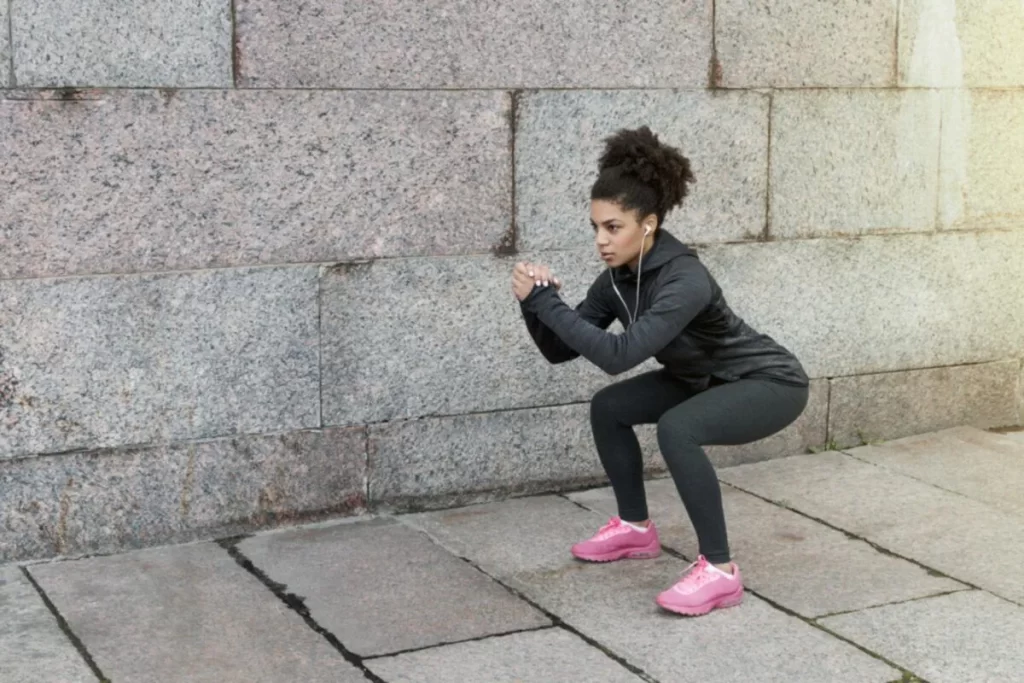Learn how to execute squats without weights to target diverse muscle groups, unleashing the full effectiveness of this muscle-building exercise. Whether your focus is on strength, joint protection, or sculpting the ideal lower body, squats stand out as an exceptional choice. However, their frequent mis performance poses a risk of missing benefits and potential injuries.
Explore the correct technique for squats to cultivate lower body strength without compromising your well-being.
The Benefits of Squats: Squats, intricate movements, engage a broad spectrum of muscles, challenging balance and coordination. Effectively working major leg and buttock muscles, including the hard-to-reach quadriceps, glutes, and hamstrings, squats prove foundational for day-to-day movements like sitting, crouching, and climbing stairs.
To fully reap the muscle-building advantages, mastering proper form for squats without weights is crucial. Here’s a step-by-step guide:
How to Squat:
- Stand with your feet shoulder-width apart, placing weight on your heels.
- Maintain an upright and open chest as your buttocks move back and down, avoiding rolling your shoulders forward.
- Ensure your knees follow a straight line parallel to your feet.
- Lower your body as far as comfortably possible, maintaining control.
- Return to an upright standing position, keeping the weight on your heels.
- Maintain a neutral head position throughout the entire movement.
Investing time in perfecting the technique ensures results without the risk of injuries, surpassing the benefits of hurried repetitions.
“Common Squat Mistakes and How to Correct Them”
Ensuring the correctness of your squatting technique is vital to prevent injuries that could impede your workout progress. Familiarizing yourself with common mistakes can aid in understanding how to rectify your form, maximizing benefits while minimizing the risk of injury.
Here are the three most prevalent squat mistakes and their corrections:
- Knees collapsing inwards:
- Mistake: Allowing knees to fall towards each other, causing stress and potential ligament damage.
- Correction: Keep your knees aligned in the same direction as your toes to safeguard joints and ligaments.
- Shallow squats:
- Mistake: Not descending low enough, missing out on full squatting benefits.
- Correction: Aim for at least a 90-degree angle with your thighs, ensuring controlled movement without going lower than you can manage.
- Arching your back:
- Mistake: Rounding your back during squats, placing stress on the lower back and risking pain or injury.
- Correction: Maintain a flat, neutral spine throughout the movement to alleviate pressure.
Squats for Beginners: Chair squats are an excellent starting point for beginners, offering a way to build strength for the complete movement while minimizing knee pain. Additionally, chair squats reduce stress on joints, lowering the risk of falls. Here’s how to perform chair squats:
- Stand in front of a chair, facing away from it.
- Execute a squat following the outlined technique.
- At the squat’s bottom, gently tap the chair with your buttocks without fully sitting down.
- Return to a standing position and repeat.”Elevate Your Lower Body Workouts with Advanced Options”For those seeking a heightened challenge in lower body workouts, consider incorporating Frog Jumps and Jump Squats. These advanced variations not only increase the intensity of your exercises but also elevate your heart rate, contributing to improved cardio fitness, enhanced mobility, and a boost in explosive strength.
“Diversify Your Squat Routine with Various Types”
Adding variety to your squat routine not only injects excitement into your workouts but also engages different muscle groups, fostering improved results. Explore these squat variations within Seven to target diverse muscle areas, build strength, and experience the burn. For a focus on the quads and outer thighs, experiment with Narrow Squats. Alternatively, direct your attention to the quads, glutes, and hip flexors with Kneeling Squats.
“Static Squats: No Movement, Maximum Impact”
Performing squats without any movement, known as isometric training, is an excellent option for situations with limited space or during travel. One notable example of isometric training is the Wall Sit, where muscle fibers are activated without any actual movement. This static squat variation allows you to engage your muscles effectively, making it an ideal choice for various scenarios.
Explore Demonstrations of These Exercises in Seven

